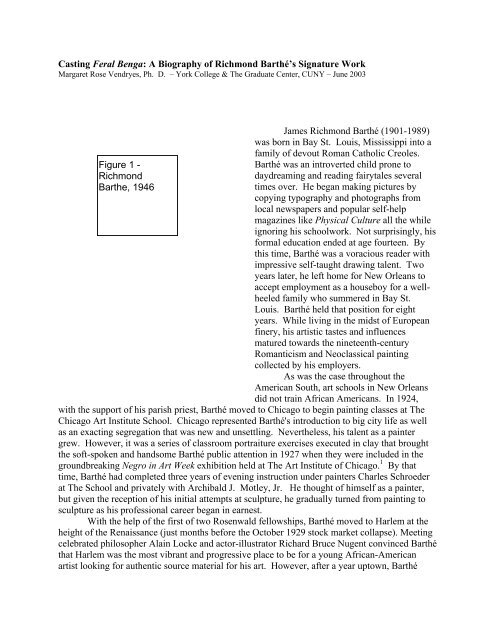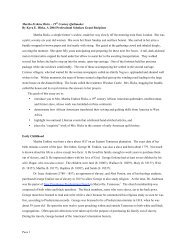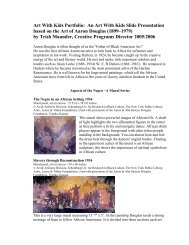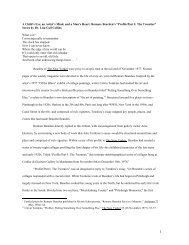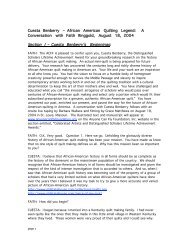Casting Feral Benga - The Anyone Can Fly Foundation, Inc.
Casting Feral Benga - The Anyone Can Fly Foundation, Inc.
Casting Feral Benga - The Anyone Can Fly Foundation, Inc.
You also want an ePaper? Increase the reach of your titles
YUMPU automatically turns print PDFs into web optimized ePapers that Google loves.
<strong>Casting</strong> <strong>Feral</strong> <strong>Benga</strong>: A Biography of Richmond Barthé’s Signature WorkMargaret Rose Vendryes, Ph. D. – York College & <strong>The</strong> Graduate Center, CUNY – June 2003James Richmond Barthé (1901-1989)was born in Bay St. Louis, Mississippi into afamily of devout Roman Catholic Creoles.Barthé was an introverted child prone todaydreaming and reading fairytales severaltimes over. He began making pictures bycopying typography and photographs fromlocal newspapers and popular self-helpmagazines like Physical Culture all the whileignoring his schoolwork. Not surprisingly, hisformal education ended at age fourteen. Bythis time, Barthé was a voracious reader withimpressive self-taught drawing talent. Twoyears later, he left home for New Orleans toaccept employment as a houseboy for a wellheeledfamily who summered in Bay St.Louis. Barthé held that position for eightyears. While living in the midst of Europeanfinery, his artistic tastes and influencesmatured towards the nineteenth-centuryRomanticism and Neoclassical paintingcollected by his employers.As was the case throughout theAmerican South, art schools in New Orleansdid not train African Americans. In 1924,with the support of his parish priest, Barthé moved to Chicago to begin painting classes at <strong>The</strong>Chicago Art Institute School. Chicago represented Barthé's introduction to big city life as wellas an exacting segregation that was new and unsettling. Nevertheless, his talent as a paintergrew. However, it was a series of classroom portraiture exercises executed in clay that broughtthe soft-spoken and handsome Barthé public attention in 1927 when they were included in thegroundbreaking Negro in Art Week exhibition held at <strong>The</strong> Art Institute of Chicago. 1 By thattime, Barthé had completed three years of evening instruction under painters Charles Schroederat <strong>The</strong> School and privately with Archibald J. Motley, Jr. He thought of himself as a painter,but given the reception of his initial attempts at sculpture, he gradually turned from painting tosculpture as his professional career began in earnest.With the help of the first of two Rosenwald fellowships, Barthé moved to Harlem at theheight of the Renaissance (just months before the October 1929 stock market collapse). Meetingcelebrated philosopher Alain Locke and actor-illustrator Richard Bruce Nugent convinced Barthéthat Harlem was the most vibrant and progressive place to be for a young African-Americanartist looking for authentic source material for his art. However, after a year uptown, Barthé
ented a cold-water, walkup apartment on the edge of Greenwich Village, which also served ashis studio. Living downtown allowed Barthé to associate with bohemian circles that welcomedhim without undue emphasis on his race and encouraged his strong interest in nude figures. Hisnudes created mixed criticism from African Americans: positive for the impressively renderedanatomy and negative for the unabashed nakedness. Downtown audiences understood andappreciated Barthé's affinity with Classical tradition and wholeheartedly embraced his use of thenude. Barthé's mostly white, and often homosexual, clientele allowed him to indulge hispenchant for the male nude, which over time became his most memorable subject matter.Dominated by actors, dancers, writers, and artists Barthé’s list of friends and patronsreads like a Who’s Who of pre-WWII homosexual society. Notable figures, like Lyle Saxon theNew Orleans journalist and historian, Winifred Ellerman, the wealthy novelist who publishedunder the name Bryher, Edgar Kaufmann, Jr., heir to the famous Pittsburgh mercantile empire,and Carl Van Vechten the stage critic turned photographer whose portraits document the era’snotable African Americans, promoted and commissioned Barthé’s sculpture. One of the mostlasting and important friendships was with the undisputed African-American arbiter of taste,Alain Locke.Barthé is the only African-American sculptor of his generation for whom the male nudewas central. Barthé’s decisive use of sensual body language for his figures was daring during anera when black men were victimized because they were considered sexually lascivious anddangerous. He left himself open to accusations of perpetuating damaging stereotypes.Subsequently, Barthé’s persistent, and successful, employment of the male nude as an object ofbeauty and desire left writers mute relative to the attention his African-American contemporariesreceived for their race-centered work. Although, decades after his celebrity waned, Barthéagreed with critics that his art was “old-fashioned,” his adept weaving of art-historical andcontemporary models, harvested from an extensive knowledge of high art and an enthusiasm forpopular trends, situated his thematic and compositional choices squarely within progressive artpractices. 2 Unfortunately, his academic forms and traditional methods obscured Barthé's boldand thoroughly up to date visual expression.In general, African-American art received tightly guarded critical treatment duringBarthé’s lifetime. Published material perpetuated a mythic homogeneity for African-Americanart that was built on the shaky foundation of shared race. 3 All black people were believed to becut from the same fabric. Subsequently, the diversity of African-American artists’ visualexpressions is only recently being fully explored. Recent analyses of African-American art havebroadened, however, historians still hesitate to investigate sexuality as a feasible and explicittheme for artists of Barthé’s generation. Without addressing Barthé's homosexuality, analyses ofhis work remain incomplete because his creative instincts were often driven by desire and sexuallonging.Barthé received a steady stream of commissions for his life-like portraits and imposingfigures. His respect and affection for men particularly resonates in the beauty of his animatedand seductive nudes. Unable to dismiss the artist all together because he was too successful andtalented, writers took refuge in dull formalist descriptions. In 1943, James Porter declared that“Barthé's handling of the nude Negro physique proclaims his gift for natural plastic feeling.” 4 Aslate as 1993 when Romare Bearden and Harry Henderson briefly acknowledged that Barthéenjoyed “singing the praises of the beauty of the body,” writers continued to offer scantanalyses. 5 Not surprisingly, critics and historians discuss <strong>Feral</strong> <strong>Benga</strong> with little more thancursory descriptions because to look deeper would require addressing Barthé's homosexuality.
<strong>The</strong> nature of Barthé’s aesthetic program is voiced inthis daring figure. It is clear that beauty alone did notdrive Barthé to consistently represent the black malebody in his art. Through the nude, Barthé revealed thebasic humanness of black men while flaunting theirsexual vitality. Years of anatomy classes at the ArtInstitute of Chicago coupled with modern dance classeshe attended in Manhattan guided Barthé as he addedemotional substance to the physical accuracy of hiswork.In 1935, Barthé created <strong>Feral</strong> <strong>Benga</strong>, a gracefulfull-figure, male nude that stands approximately twofeet high. <strong>The</strong> work of art, as well as the artist’sencounter with the man it portrays, marks a criticalmoment in the art and life of this accomplishedacademic sculptor. <strong>Feral</strong> <strong>Benga</strong> is Barthé's signaturepiece. He completed the figure within a few monthsafter seeing <strong>Benga</strong> perform. As one of severalemerging African-American artists taking stock in theNegro art renaissance philosophy formed a decade earlier, Barthé celebrated all that wasinteresting and pleasing about blackness. As the country recovered from economic collapse,African-American artists began to commemorate their race in earnest, not only through depictingrace-specific themes but, also taking more seriously their aesthetic connections to Africa. Withdignity, Barthé effectively brought the black male bodyinto the respectable fine art arena.Both dancer and sculpture presented Africa inan accessible, non-threatening modern package cast onthe stage and in bronze. François <strong>Benga</strong>, theSenegalese cabaret dancer immortalized in Barthé'ssculpture, was himself cast in changeable roles on andoff stage. 6 Since his arrival in Paris, François became<strong>Feral</strong> <strong>Benga</strong>, a professional chorus dancer whoappeared with stars, like Josephine Baker, who droveParisian audiences wild with carnal choreography oftenset in steamy and distant places. After seeing Bakerperform in Paris, French poet Jean Cocteau exclaimedthat finally “eroticism had found a style.” 7 <strong>Benga</strong>’sexotic and feral stage persona made him a sought-aftercompanion within trendy bohemian circles.Barthé saw <strong>Benga</strong> perform during his first visitto Paris in 1934. He began visualizing his memories ofParis and the ‘authentic’ African dancer in his NewYork studio immediately upon his return. Ironically,Barthé’s <strong>Feral</strong> <strong>Benga</strong> met with a similar fate as the dancer. While exhibited in up-scale fine artgalleries and priced accordingly, the sculpture was privately admired for its audacious sexualallure. 8
By the time <strong>Feral</strong> <strong>Benga</strong> was completed, Barthé had skillfully established his relationshipwith both white and black Manhattan. As mentioned earlier, his search for professional andsocial freedom ended below 34 th Street among more diverse and mainstream artists andcollectors. However, Barthé quickly realized that freedom in an integrated neighborhood wasrelative not absolute, and further that homosexuals faced limitations regardless of location. 9Culture critic Manthia Diawara observed that open expression afforded white gays, within andwithout their communities, does not often extend to black gays who function under “thecamouflage of expressive forms such as music, dance, and transvestite attires, which are morereassuring to heterosexuals.” 10 Barthé revealed himself exclusively to those men and women ‘inthe life’; outside of those circles, he remained aloof and sexually neutral. He joined the HarlemArtists Guild, but was never an active member. 11 Once Barthé moved out of Harlem, his socialinvolvement was limited at best. His disinterest in women and marriage was considered areflection of Barthé's devotion to his art. With barriers compounded by race, black gay menexperience a heighten awareness of their otherness especially within black communities wherereligion, and a wish to be seen as ‘normal,’ leaves very little tolerance for alternate life ways.Barthé’s sculpture was his ‘camouflage.’ Nudes based on Classical models madecelebrating his homosexuality possible, while protecting the heterosexual public identity Barthéadvanced throughout his life. <strong>The</strong> sculptor also often gave his figures generic titles whicheffectively concealed the identities of individuals who inspired or posed for his genre figures. 12<strong>The</strong>y were also often hybrid compositions. For example, a dancer’s torso might be carried by thelegs of a basketball player, and the handsome face of a young street urchin would crown theassemblage. However, <strong>Feral</strong> <strong>Benga</strong>, actually titled for its living model, is a unique glimpse ofhow Barthé reinvented contemporaries realities to suit his taste for Classical art and its 16 thcentury renaissance.When Barthé visited Paris in 1934, <strong>Benga</strong> was already notorious in American andEuropean bohemian circles. <strong>The</strong> following year, then-amateur anthropologist Geoffrey Gorer’sAfrica Dances: A Book About West African Negroes was published. This slim volume’s travellogprose and snapshot photography became popular among Negrophiles interested in all aspectsof black culture. Africa Dances was dedicated to <strong>Benga</strong> who accompanied Gorer on his researchjourney through Western Africa. 13 Barthé’s knowledge of African dance developed with the helpof Gorer’s book, and his knowledge about <strong>Benga</strong> also increased.In his book, Gorer identified two distinct types of African dance – warlike and orgasmic.For Barthé the two types were interdependent. In <strong>Feral</strong> <strong>Benga</strong>, violence and sensuality vie fordominance, pain mingles with pleasure, male blends with female, and popular culture breaths lifeinto high art representation. A thoroughly self-contained figure, <strong>Feral</strong> <strong>Benga</strong> swoons trance-likein ecstasy. Such sexual innuendo boldly written on the black body was risqué for the time, butnot untapped by other artists. <strong>Feral</strong> <strong>Benga</strong>’s veiled androgyny was akin to the work of Barthé’sclose friend Richard Bruce Nugent. 14 Nugent was an eccentric artist who took great joy in overtdisplays of the Renaissance era’s propensity for racial and sexual intermingling by often layeringmultiple significations into his amusing and audacious drawings. 15 His Drawings for Mulattoes,for example, were Rorschach tests where each viewer brought something new to the picture.Racial, cultural, and gender bifurcation are tightly woven into complex narratives offered up indeceivingly simple forms. <strong>The</strong>se expressive methods were endemic to artists who, likechameleons, adjusted their identity to their immediate environment. What is revealed on thesurface might appear adequate, but what lies beneath offers substance.
<strong>Feral</strong> <strong>Benga</strong> is one of several African dancing figures in Barthé's oeuvre. In 1933,Barthé completed African Dancer (Whitney Museum of American Art) his first and largestdancing figure. He composed ‘African’ dancers using a variety of sources, such as his ownmirror image, photographs or other works of art. Barthé's primary interest in arresting humananatomical movement took precedence over depicting ethnic authenticity. Subsequently, AfricanDancer was praised for its uncompromising authenticity, despite the fact that the figure'sheadband and pelvic covering are associated with no existing African ethnic identity.Apparently, Barthé's own blackness added authenticity to his African Dancer. <strong>Feral</strong> <strong>Benga</strong> was,without a doubt, authentic without the help of the artist’s ethnicity.<strong>Feral</strong>, a tidy word meaning wild animal enhanced the dancer’s exotic appeal. 16 He wasAfrican and ‘wild.’ Parisian public relations agents created a persona for <strong>Benga</strong>, which wasdirectly opposite the shy and introverted François. 17 Amidst the glitter and romance of Paris,<strong>Benga</strong>, albeit on a Parisian stage, was the first flesh-and-blood African Barthé had met. His keenmemory made the sensual foundation of Barthé's sculpture possible, but he relied heavily onphotographic aides, to assure visual accuracy. It is unlikely that <strong>Benga</strong> ever appeared naked onstage, but for Barthé nudity was the key to a timeless art that avoided the thorny trappings ofculture and class. 18 <strong>The</strong> realism of the body was key to Barthé's work.Nudity was considered Africa’s ‘authentic’ costume by Westerners, even though it wasclear that nakedness in West Africa was uncommon, and that references to it was a source ofembarrassment for colonized Africans. 19 Africa’s ‘proud’ nudity became a model of personalfreedom to countless repressed members of clothed societies. In fact, African nakedness, as anatural way of being, attracted many European and American artists to the sculpture andtraditions of what was once known as the ‘dark’ continent. Even with its theatrical presence anddiminutive size, <strong>Feral</strong> <strong>Benga</strong> appears surprisingly natural. <strong>The</strong> figure’s full frontal nudity,coupled with the large sword held aloft, commingled rapt passivity (the orgasmic tilt of the head,closed eyes, and tightly-clamped thighs) with suspended activity (bent knees, raised heels andswirling arms). <strong>The</strong> figure’s elongated waist separates the heart from the genitals and creates acompositional balancing act between love and sex. Viewers can indulge their senses for, witheyes shut, there is an open invitation to do so. <strong>The</strong>n there is the threatening weapon held tightlyoverhead. Dances like Le Pilé Feuille come to mind. A retention of traditional West Africanrituals kept alive in Haitian folk dance, Le Pilé Feuille includes the machete used tometaphorically cut away evil. With this in mind, the potential violence of <strong>Feral</strong> <strong>Benga</strong>’s fallingblade is diffused. Barthé strove to balance European tradition with modernity and incorporateelements specific to African-American heritage. He succeeded in <strong>Feral</strong> <strong>Benga</strong>.Barthé’s artistic balancing acts were particularly complex in <strong>Feral</strong> <strong>Benga</strong>. He wanted tolink his art to an imagined, artistic Africa that described the vast African Diaspora and still findfavor with wealthy, white collectors. By integrating classical ballet’s smooth and studiedmovement with frenetic and often improvisational black folk dance, Barthé expressed his ownsophistication and multi-ethnicity. With his mix of French, American Indian, and Africanancestry, Barthé cast a wider net than most in gathering inspirations and ideas. He feltauthorized, indeed compelled, as a trained professional with European ancestors to measure up torecognized master artists.
Antonio Pollaiuolo’s Battle of the NakedMen (c.1465) in <strong>The</strong> Metropolitan Museum ofArt collection must have caught Barthé’s eye onhis many visits to that museum. <strong>The</strong> etching,picturing what appears to be man’s battle withhis many identities, contains identical models ina variety of poses. <strong>The</strong> scene is static, eventhough a fierce battle is underway, andintensified by how difficult it is to distinguishenemies from comrades among them.Unprotected bodies stretch out and open like<strong>Feral</strong> <strong>Benga</strong> exposed to the sharp metal ofsweeping weapons. Although standing alone, a similar tension is sensed in <strong>Feral</strong> <strong>Benga</strong> as onemoves around to set the figure in motion. <strong>The</strong> dancer appears vulnerable and unstable from theside, powerful and unpredictable from the front, and decidedly erotic from behind. Whenwielding a heavy blade such as that hanging above <strong>Feral</strong> <strong>Benga</strong>’s head, one miscalculated movewould surely result in injury.<strong>The</strong> art historical models for Barthé's sculpture areoften recognizable, but early critics overlooked Europeaninfluences when writing about African-American art becausesuch borrowing was believed to undermine the ‘originality’ ofblack expression. <strong>The</strong>refore, comparing <strong>Feral</strong> <strong>Benga</strong> to afifteenth-century Italian print was never considered.However, Barthé and Pollaiuolo have more thancompositional affinities. <strong>The</strong> public acceptance of both Battleof Naked Men and <strong>Feral</strong> <strong>Benga</strong> was due, in part, to theiridealized structures, which rendered nudity noble rather thansexual (at least on the surface). Mythological figures,theatrical performances, or images of far off continents likeAfrica and Asia offered a comfortable distance between artand audience for displaying the undressed body. However,black nudes based on classical models, a convention notwidely used in fine art, which did enjoy limited popularity as the ‘noble’ African savage in the18 th century, boldly resurfaced in the late 20 th century as Robert Mapplethorpe’s homoeroticphotographs proudly declare.Although <strong>Benga</strong> used his popularity as a native African to advantage in Paris and NewYork, he dreamed of forming an authentic West African dance troupe for European andAmerican audiences that did not compromise the fundamental passion of tribal movement. By1937, when he visited New York, Manhattan’s appetite for African dance was already whettedby Asadata Dafora and Randolph Sawyer who choreographed elaborate African-based dances forthe urban stage. 20 Even so, <strong>Benga</strong>’s beauty caused quite a stir in New York’s homosexualcircles. Prior to the advent of the gay liberation movement, homosexuals carefully guarded theiridentities in public. However, gay artists often deliberately employed high art portrayals of malenudity in covert celebration of a sexual orientation others deemed socially aberrant. <strong>Benga</strong>’sflawless, hairless, and often-exposed, brown skin inspired gay artists like Van Vechten and PavelTchelitchev. Both made portraits of the dancer during his New York visit. Van Vechten
photographed <strong>Benga</strong> holding white water lilies against his bare chest while staring into thecamera like an amphibian rising out of a pond. <strong>Benga</strong> also modeled for Tchelitchev’s paintingDeposition, a bizarrely oriented composition that leaves the viewer hovering over a naked man indespair being sucked into a void. <strong>Benga</strong>’s face and physique inspired others but Barthé's portraitstatuette had no equal.Alain Locke, one of several homosexual men of public stature from the HarlemRenaissance era, admired Barthé and collected his art. Locke was as careful as he was clever inmaintaining an uncompromisingly private advocacy of same sex relationships throughout hislife. He preferred the subtlety of Walt Whitman to the audacity of Oscar Wilde becauseWhitman was openly embraced as a man’s man without being marked as homosexual. 21 Locke,as expected, included <strong>Feral</strong> <strong>Benga</strong> along with a dozen other Barthé works in his 1940 pictorialsurvey <strong>The</strong> Negro in Art: A Pictorial Record of the Negro Artist and of the Negro <strong>The</strong>me in Artbecause Barthé's work elegantly merged Afrocentric themes with Eurocentric methods. Locke’scaption for <strong>Feral</strong> <strong>Benga</strong> read “<strong>Benga</strong>: Dance Figure” emphasizing the portrait and downplayingthe sensationalism inherent in the dancer’s stage persona as well as the figure’s nudity. 22<strong>Feral</strong> <strong>Benga</strong> was first exhibited in the celebrated 1937 Dance International exhibition atRockefeller Center, however, it was not pictured in the exhibition’s copiously illustrated catalog.<strong>The</strong> earliest of over a dozen published photographs of this popular sculpture was in Locke’s1940 survey. <strong>The</strong> sculpture’s photogenic quality made it the natural choice to illustrate laterexhibition catalogs and art historical texts. When reviewed together, these photographs areinstrumental for dating casts of known copies. New Jersey’s Newark Museum boasts the onlymuseum held cast of <strong>Feral</strong> <strong>Benga</strong> from the 1930s. Newark’s <strong>Feral</strong> <strong>Benga</strong> is one of only twoknown links to Barthé’s 1935 clay model. 23 Over fifty years later, subtle but significant changeswere made when Barthé, inspired by a revitalized interest in his early work, allowed the figure tobe cast in a new edition.At the height of his career, Barthé took great pains with the finish of his sculpture.Foundry work received vigilant scrutiny to ensure that the bronze was chased to a seamlessfinish and read true to its original clay model. <strong>The</strong> traces of pulled and smoothed clay createdwith fingers and tools animate figures like <strong>Feral</strong> <strong>Benga</strong> and act as a road map of Barthé'smeticulous rendering methods. This practice also reflected his admiration for the late 19 thcentury French master Auguste Rodin who left impressions on surfaces that are his signature.Barthé also chose his patinas with sensitivity. His belief in the visceral impact of colorcame from his formal training in oil painting. Newark’s <strong>Feral</strong> <strong>Benga</strong>, a deep blackened brown,perches on a round, thin disk pooled under the figure’s feet like a spotlight bathing over theperformer. Dominating the robust lower body, large bulging thighs are tensed by an elevatedpose struck on the balls of its feet. In contrast, the elastic midsection stretches up and fans outinto a ribcage that supports propelling arms forming parentheses along a vertical axis. <strong>The</strong>handle of the machete-arched overhead protrudes beyond the figure’s right palm, its sturdy bladeslightly widened before ending at a point that guides the eye down and around once more.Allusions to Sigmund Freud’s theories of phallic substitution and fear of castration aresimultaneously made as the only inorganic element, the machete, represents a literal andmetaphorical double-edged sword. <strong>Feral</strong> <strong>Benga</strong>’s portrait-quality face documents not only thelook of this engaging performer, but the psychic escape he found in dance.
What appear as minor differences between the two<strong>Feral</strong> <strong>Benga</strong> editions of , separated by more than fifty years,actually alter the figure’s rhythm and visual impact. <strong>The</strong> editioncast in 1986 represents an artist distanced by advanced age anddisengagement with the subject. Details that would have ensuredfidelity to the earlier casts went unchecked and are perhaps a signthat the later edition was market driven rather than guided byartistic concerns. For example, the palm of <strong>Feral</strong> <strong>Benga</strong>’s hand inthe 1986 edition completely envelops the machete handle.Without the handle’s butt making the instrument distinct from thefigure’s hand, the blade flows like a licentious extension. <strong>The</strong>base, thicker and smaller, is a platform that no longer reminds usof the spotlights that illuminated <strong>Benga</strong> and captured Barthé’simagination. Both machete and base, cast separately and thenwelded to the finished bronze figure became mere plastic props.But, the most overwhelming difference between the two is thesurface finish. 24<strong>The</strong> exterior of the 1986 edition lacks the signature tracesof the sculptor’s hands. <strong>The</strong>se track marks Barthé left imbedded his working life into thesurface, the time he spent creating the work, into his art. <strong>The</strong> overall shimmer created by lighton the 1935 <strong>Feral</strong> <strong>Benga</strong> clings like perspiration on a exhausted dancer’s body. It remainsunknown how involved the octogenarian Barthé was with the 1986 casting of <strong>Feral</strong> <strong>Benga</strong>. 25More in line with his work from the 1960s and after, but in stark contrast with the 1935 <strong>Feral</strong><strong>Benga</strong>, the slick surface on the later model robs the figure of its powerful tactile qualities anddeadens its once erotic impact – an echo of the original.<strong>The</strong> lost casts of the exquisite <strong>Feral</strong> <strong>Benga</strong> will no doubt find their way to center stage asRichmond Barthé’s art receives long-overdue celebration. <strong>Feral</strong> <strong>Benga</strong>, a portrayal of a modernAfrican ‘acting savage,’ is much more than choreographed or contrived ethnicity. It is a keywork in Barthé’s autobiography, the era’s history, and a forgotten dancer’s memory. <strong>Feral</strong><strong>Benga</strong> is 20 th century American sculpture at its provocative best.
Illustration Credits:Figure 1. Photographer Unknown. Portrait of Richmond Barthé. Harmon <strong>Foundation</strong> portfolio,1946.Figure 2. Richmond Barthé. <strong>Feral</strong> <strong>Benga</strong>, 1935. Bronze, 19_ inches high. Harmon <strong>Foundation</strong>portfolio, 1946.Figure 3. Rosardy Studio, Paris. <strong>Feral</strong> <strong>Benga</strong> in costume, c.1934. Black and white photograph.Private collection.Figure 4. Antonio del Pollaiuolo, Battle of Naked Men, c.1465. Engraving, 15 x23 inches. <strong>The</strong>Metropolitan Museum of Art. Image downloaded on 6-30-03 from http://www.kgi.ruhr-unibochum.de/raffael/kap_2/kap_2_2.htmFigure 5. Robert Mapplethorpe, Ken and Tyler, c. 1984. Black and white photograph. Image downloadedon 6-30-03 from http://www.zabtuze.com/summer2002/censor.htmlFigure 6. Richmond Barthé. <strong>Feral</strong> <strong>Benga</strong>, 1935 (cast in 1986). Bronze, 19_ inches high. PrivateCollection.
Notes:1 <strong>The</strong> Negro in Art Week was the first fine arts exhibition devoted to African and African-American artists in a majorAmerican art museum.2 <strong>The</strong>re are several instances where Barthé referred to his art as “old-fashioned.” One that stands out was in 1965when his entry for the first international exhibition of black art to be held in Dakar, Senegal was rejected. Hebelieved this was due to the traditional nature of his work. Richmond Barthé to Hershel Shohan, 20 December1965. Private collection.3 Kymberly N. Pinder pointed out in “Black Representation and Western Survey Textbooks” (Art Bulletin 81, Sept.1999) that this practice is most damaging in survey texts when the complexities in art made by African Americansare explained away by race in unavoidably brief entries.Censorship aimed at preserving the memory of African-American artists also deadens the writing about African-American art. One particularly disturbing instance of censorship occurred when art historian Judith Wilson wasdenied the right to reproduce any of Romare Bearden’s images because his executors found her essay “offensive,inaccurate and ...damaging to the reputation of the late Mr. Bearden.” Judith Wilson, “Getting Down to Get Over:Romare Bearden’s Use of Pornography and the Problem of the Black Female Body in Afro-U.S. Art,” in Gina Dent,ed., Black Popular Culture (Seattle: Bay Press, 1992), 15.4 James Porter, Modern Negro Art (reprint; 1943, Washington, D.C.: Howard University Press, 1992), 126.5 Romare Bearden and Harry Henderson, A History of African-American Artists: From 1792 to the Present (NewYork: Pantheon Books, 1993), 144.6 <strong>Feral</strong> <strong>Benga</strong>, born into Senegal’s dominant Wolof tribe, was the illegitimate grandchild of one of Dakar’s richestproperty owners. In 1925, shortly after being disinherited by his father, he left Dakar for Paris. For morebackground on <strong>Benga</strong> see Geoffrey Gorer, African Dances: A Book About West African Negroes (London: Faber &Faber, 1935).7 Vincent Cronin, Paris: City of Light, 1919-1939 (New York: HarperCollins, 1994), 126.8 Unfortunately, the number of <strong>Feral</strong> <strong>Benga</strong> figures cast during Barthé’s long life, and their present locations, remaina mystery. Only late in life with dimming memory did Barthé find merit in recording the details of art sold or givenas gifts. <strong>The</strong> <strong>Feral</strong> <strong>Benga</strong> bronze exhibited in Rhapsodies in Black is one of ten from the last edition cast in 1986three years before Barthé's death.9 Barthé’s brother, who lived with the artist on West 25 th Street from the mid to late 1930s, recalled how difficult itwas for Barthé to be himself in Harlem society because, as a black celebrity, his words and actions were heavilyscrutinized. However, the downtown social scene had its problems as well. Barthé understood that he would not beserved at certain establishments unless accompanied by a white patron. Louis Franklin interviewed by the author, 1May 1993.10 Manthia Diawara, “<strong>The</strong> Absent One: <strong>The</strong> Avant-Garde and the Black Imaginary in Looking For Langston,” inMarcellus Blount and George P. Cunningham, Representing Black Men (New York: Routledge, 1996), 215.11 Later in life, Barthé could not recall having been associated with the Harlem Artists Guild although he did havefriends who were active members and his name appears on the Guild’s roster. This is understandable since theGuild’s 1935 ‘manifesto’ against “coddling rather than professional attitude toward Negro art” of the Harmon<strong>Foundation</strong> was caustic. Barthé, championed by the <strong>Foundation</strong> well into the 1960s, adamantly disagreed with theGuild’s stand. Barthé interviewed by Camille Billops, audiotape, St. Albans, NY, 9 December 1975. Hatch-BillopsCollection, New York, New York.12 For example, <strong>The</strong> Boxer, 1941 (<strong>The</strong> Metropolitan Museum of Art) was Tiger McWay, a guard at the SavoyBallroom, and Boy with a Flute, 1939 (private collection) was Allen Meadows, an aspiring amateur dancer.13 According to Gorer, <strong>Benga</strong> was a “Europeanized African… whose position in Paris was rather like that of thefashionable divorcée in the nineteenth century: a person whom it was chic to be seen with in the right places” andinappropriate everywhere else (7) Although Gorer’s book was considered a significant contribution to WestAfrican dance history, on closer scrutiny his interest in Africa appears similar to the motivation for his first book<strong>The</strong> Revolutionary Ideas of the Marquis de Sade. Gorer recorded with delight, equal to that he took in the dancesthemselves, what he determined was the sadistic sexual behaviors of West Africans. <strong>The</strong>se ‘facts’ added spice to theostensibly social/scientific text and must have increased sales as well.14 I am grateful to Thomas Wirth for his willingness to share his extensive knowledge about Nugent. His editorialsavvy and enlightened introduction in Richard Bruce Nugent, Gay Rebel of the Harlem Renaissance (Durham: DukeUniversity Press, 2002) produced the definitive work on the artist.
15 Susan Gubar described Nugent’s drawings as “an etiological narrative about the interdependence of black andwhite in the evolution of American culture,” but Nugent’s unusual (for the time) openness about his homosexualityallows for an equally relevant reading of same-sex race relations and cross-gender hybridization overtly displayed inhis art. Susan Gubar, Racechanges: White Skin, Black Face in American Culture (New York: Oxford UniversityPress, 1997), 107-112.1616 Ironically, Wolof family names do refer to animals; <strong>Benga</strong> is the jackal, a small wild dog.17 In retrospect, the pseudonym was fitting for a cunning and handsome young man who negotiated elite Europeanand American circles with finesse and a well-tuned black body.18 Barthé would have agreed with critic John Berger when he neatly described nakedness in fine art as “a form ofdress.” Berger quoted in Paul Ableman, Anatomy of Nakedness (London: Orbis Publishing, 1982), 50.19 Gorer, 165.20 For more on this topic see Richard Long, <strong>The</strong> Black Tradition in American Dance (London: Prion, 1989).21 Alain Locke, <strong>The</strong> Survey Graphic (Fall 1927): 563.22 <strong>Feral</strong> <strong>Benga</strong> was not titled as such until 1947 when it was shown in Barthé’s final one-man exhibition at GrandCentral Galleries in New York. It was titled “<strong>Benga</strong>” before that date.23 <strong>The</strong> second known 1930s cast of <strong>Feral</strong> <strong>Benga</strong> is in the Joyce & George Wein collection, New York.24 Right-handed, Barthé mirrored himself by putting the machete in the figure’s right hand. An unfortunateoversight left <strong>Feral</strong> <strong>Benga</strong> inverted in Richard J. Powell’s exhibition catalog for Rhapsodies in Black: Art of theHarlem Renaissance (University of California Press, 1997), 73.25 It is also unknown what model was used to create the mold for the 1986 edition leaving this open to speculation.No plaster has been identified, and the traditional edition of 6 casts to a mold was increased to 10.


